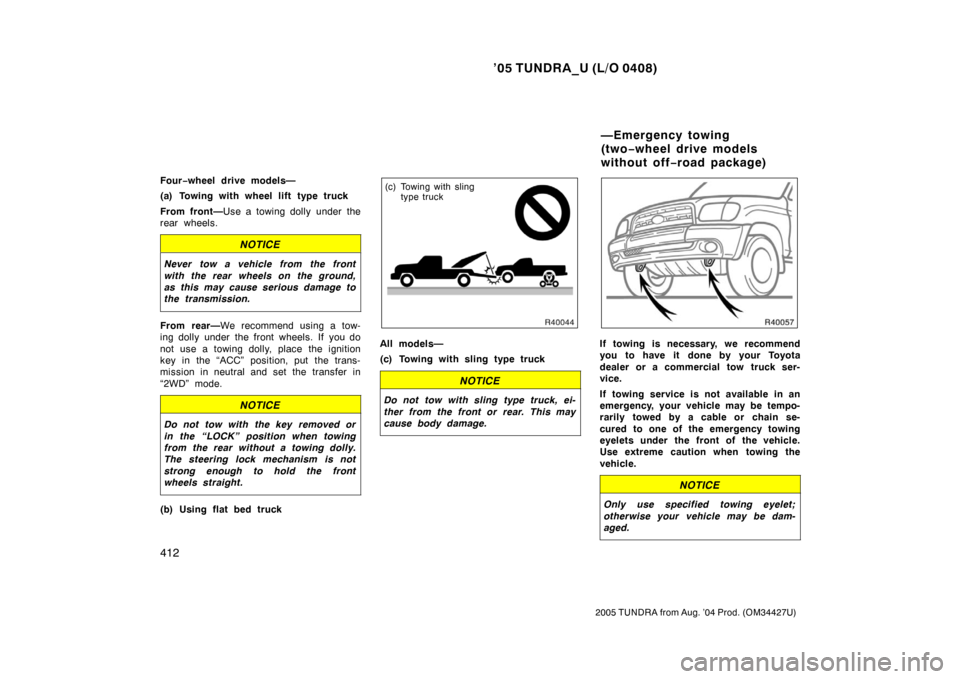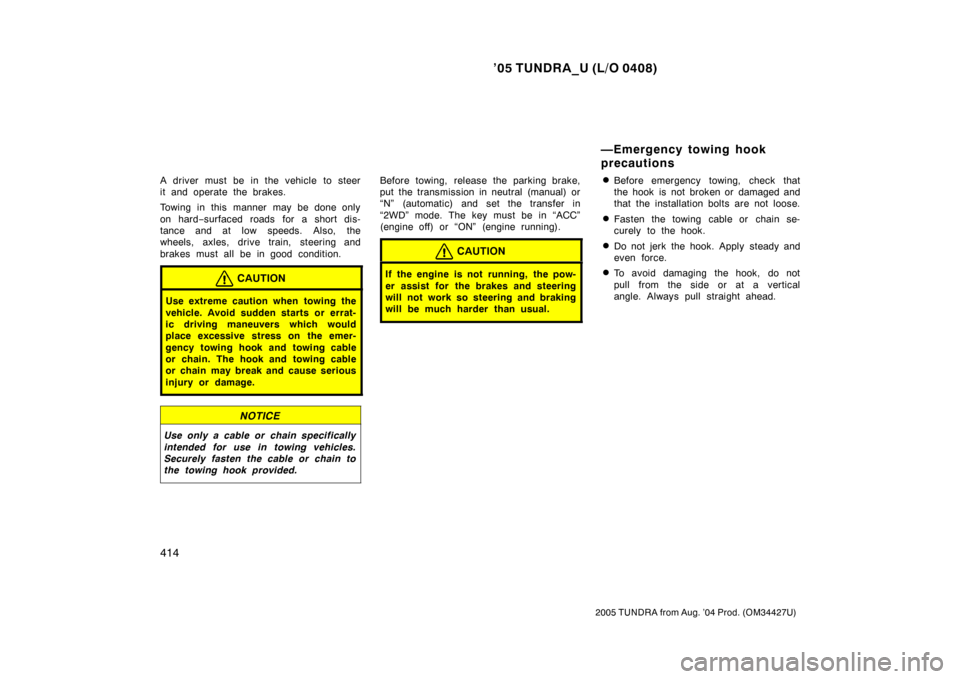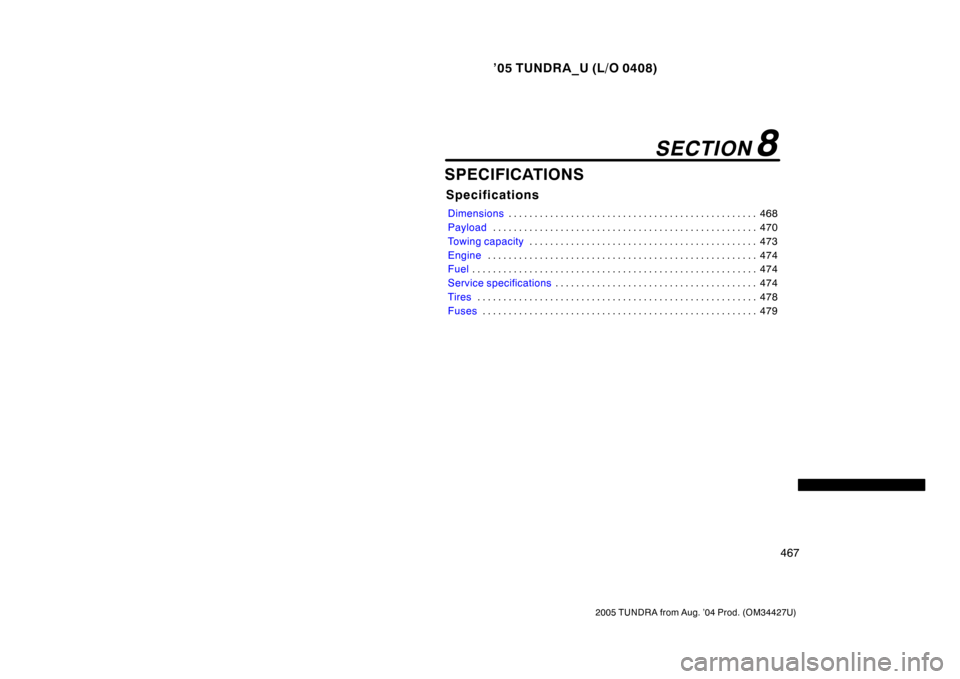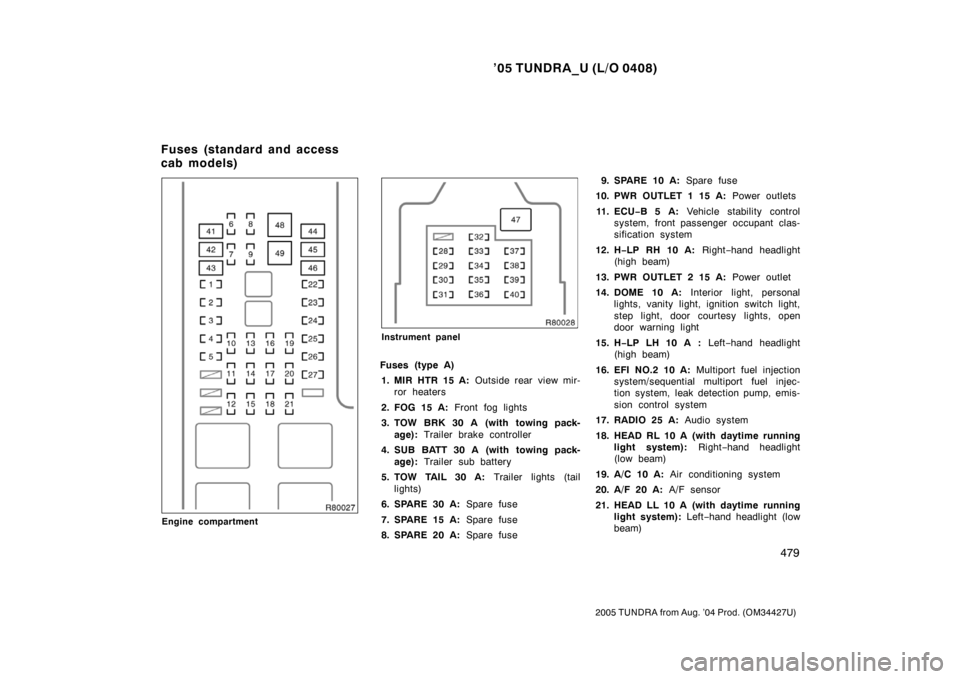Page 423 of 506

’05 TUNDRA_U (L/O 0408)
412
2005 TUNDRA from Aug. ’04 Prod. (OM34427U)
Four−wheel drive models—
(a) Towing with wheel lift type truck
From front— Use a towing dolly under the
rear wheels.
NOTICE
Never tow a vehicle from the front
with the rear wheels on the ground,
as this may cause serious damage to
the transmission.
From rear— We recommend using a tow-
ing dolly under the front wheels. If you do
not use a towing dolly, place the ignition
key in the “ACC” position, put the trans-
mission in neutral and set the transfer in
“2WD” mode.
NOTICE
Do not tow with the key removed or
in the “LOCK” position when towing
from the rear without a towing dolly.
The steering lock mechanism is not
strong enough to hold the front
wheels straight.
(b) Using flat bed truck
(c) Towing with sling type truck
All models—
(c) Towing with sling type truck
NOTICE
Do not tow with sling type truck, ei-
ther from the front or rear. This may
cause body damage.
If towing is necessary, we recommend
you to have it done by your Toyota
dealer or a commercial tow truck ser-
vice.
If towing service is not available in an
emergency, your vehicle may be tempo-
rarily towed by a cable or chain se-
cured to one of the emergency towing
eyelets under the front of the vehicle.
Use extreme caution when towing the
vehicle.
NOTICE
Only use specified towing eyelet;
otherwise your vehicle may be dam-
aged.
—Emergency towing
(two −wheel drive models
without off −road package)
Page 424 of 506

’05 TUNDRA_U (L/O 0408)
413
2005 TUNDRA from Aug. ’04 Prod. (OM34427U)
A driver must be in the vehicle to steer
it and operate the brakes.
Towing in this manner may be done only
on hard− surfaced roads for a short dis-
tance and at low speeds. Also, the
wheels, axles, drive train, steering and
brakes must all be in good condition.
CAUTION
Use extreme caution when towing the
vehicle. Avoid sudden starts or errat-
ic driving maneuvers which would
place excessive stress on the emer-
gency towing eyelet and towing cable
or chain. The eyelet and towing cable
or chain may break and cause serious
injury or damage.
NOTICE
Use only a cable or chain specifically
intended for use in towing vehicles.
Securely fasten the cable or chain to
the towing eyelet provided.
Before towing, release the parking brake
and put the transmission in neutral (manu-
al) or “N” (automatic). The key must be
in “ACC” (engine off) or “ON” (engine run-
ning).
CAUTION
If the engine is not running, the pow-
er assist for the brakes and steering
will not work so steering and braking
will be much harder than usual.
If towing is necessary, we recommend
you to have it done by your Toyota
dealer or a commercial tow truck ser-
vice.
If towing service is not available in an
emergency, your vehicle may be tempo-
rarily towed by a cable or chain se-
cured to the emergency towing hook
under the front of the vehicle. Use ex-
treme caution when towing the vehicle.
NOTICE
Only use specified towing hook;
otherwise your vehicle may be dam-
aged.
—Emergency towing (four −wheel
drive models and two− wheel drive
models with off −road package)
Page 425 of 506

’05 TUNDRA_U (L/O 0408)
414
2005 TUNDRA from Aug. ’04 Prod. (OM34427U)
A driver must be in the vehicle to steer
it and operate the brakes.
Towing in this manner may be done only
on hard− surfaced roads for a short dis-
tance and at low speeds. Also, the
wheels, axles, drive train, steering and
brakes must all be in good condition.
CAUTION
Use extreme caution when towing the
vehicle. Avoid sudden starts or errat-
ic driving maneuvers which would
place excessive stress on the emer-
gency towing hook and towing cable
or chain. The hook and towing cable
or chain may break and cause serious
injury or damage.
NOTICE
Use only a cable or chain specifically
intended for use in towing vehicles.
Securely fasten the cable or chain to
the towing hook provided.
Before towing, release the parking brake,
put the transmission in neutral (manual) or
“N” (automatic) and set the transfer in
“2WD” mode. The key must be in “ACC”
(engine off) or “ON” (engine running).
CAUTION
If the engine is not running, the pow-
er assist for the brakes and steering
will not work so steering and braking
will be much harder than usual.
�Before emergency towing, check that
the hook is not broken or damaged and
that the installation bolts are not loose.
�Fasten the towing cable or chain se-
curely to the hook.
�Do not jerk the hook. Apply steady and
even force.
�To avoid damaging the hook, do not
pull from the side or at a vertical
angle. Always pull straight ahead.
—Emergency towing hook
precautions
Page 426 of 506

’05 TUNDRA_U (L/O 0408)
415
2005 TUNDRA from Aug. ’04 Prod. (OM34427U)
CAUTION
If the emergency towing hook is used
to get out when your vehicle becomes
stuck in the mud, sand or other
condition from which the vehicle can-
not be driven out under its own pow-
er, make sure to observe the precau-
tions mentioned below. Otherwise, ex-
cessive stress will be put on the
hook and the towing cable or chain
may break, causing serious injury or
damage.
�If the towing vehicle can hardly
move, do not forcibly continue the
towing. Contact your Toyota dealer
or a commercial tow truck service
for assistance.
�Tow the vehicle as straight ahead
as possible.
�Keep away from the vehicle during
towing.
The following methods are effective to
use when your vehicle is stuck in the
mud, sand or other condition from
which the vehicle cannot be driven out
under its own power. Use extreme cau-
tion when towing the vehicle. In addi-
tion, keep away from the vehicles and
towing cable or chain when towing.
�Remove the sand and soil in the front
and the back of the tires.
�Place stones or wood under the tires. You can purchase a new key at your
Toyota dealer if you can give them the
key number.
See the suggestion given in “Keys” in
Section 1
−2.
If your keys are locked in the vehicle and
you cannot get a duplicate, many Toyota
dealers can still open the door for you,
using their special tools. If you must
break a window to get in, we suggest
breaking the smallest side window be-
cause it is the least expensive to replace.
Be extremely cautious to avoid cuts from
the glass.
—Tips for towing a stuck
vehicle If you lose your keys
Page 478 of 506

’05 TUNDRA_U (L/O 0408)
467
2005 TUNDRA from Aug. ’04 Prod. (OM34427U)
SPECIFICATIONS
Specifications
Dimensions 468
. . . . . . . . . . . . . . . . . . . . . . . . . . . . . . . . . . . . \
. . . . . . . . . . . .
Payload 470
. . . . . . . . . . . . . . . . . . . . . . . . . . . . . . . . . . . . \
. . . . . . . . . . . . . . .
Towing capacity 473
. . . . . . . . . . . . . . . . . . . . . . . . . . . . . . . . . . . . \
. . . . . . . .
Engine 474
. . . . . . . . . . . . . . . . . . . . . . . . . . . . . . . . . . . . \
. . . . . . . . . . . . . . . .
Fuel 474
. . . . . . . . . . . . . . . . . . . . . . . . . . . . . . . . . . . . \
. . . . . . . . . . . . . . . . . . .
Service specifications 474
. . . . . . . . . . . . . . . . . . . . . . . . . . . . . . . . . . . . \
. . .
Tires 478
. . . . . . . . . . . . . . . . . . . . . . . . . . . . . . . . . . . . \
. . . . . . . . . . . . . . . . . .
Fuses 479
. . . . . . . . . . . . . . . . . . . . . . . . . . . . . . . . . . . . \
. . . . . . . . . . . . . . . . .
SECTION 8
Page 483 of 506
’05 TUNDRA_U (L/O 0408)
472
2005 TUNDRA from Aug. ’04 Prod. (OM34427U)
∗
1
: With towing package∗2: With electric moon roof∗3: Without optional equipment∗4: See “Model code” on page xi in the beginning of this m anual if you are not sure of which model your vehicle is.∗
5:
Maximum payload including weight of driver, passengers, optional equipment and cargo
∗ 6: Installing accessories in addition to those installed at the factory increases the weight of the vehicle, thereby reducing
payload. Contact your Toyota dealer about the weight of accessory parts.
Page 484 of 506
’05 TUNDRA_U (L/O 0408)
473
2005 TUNDRA from Aug. ’04 Prod. (OM34427U)
kg (lb.)
Standard cab
models
1GR −FE engineTw o −wheel drive modelsWithout towing package2358 (5200)
2UZ −FE engine
Tw o −wheel drive modelsWithout towing package2494 (5500)
With towing package3311 (7300)
Four −wheel drive modelsWithout towing package2494 (5500)
With towing package3311 (7300)
Access cab models
1GR −FE engineTw o −wheel drive modelsWithout towing package2268 (5000)
2UZ −FE engine
Tw o −wheel drive modelsWithout towing package2494 (5500)
With towing package3311 (7300)
Four −wheel drive modelsWithout towing package2358 (5200)
With towing package3175 (7000)
Double cab models2UZ −FE engine
Tw o −wheel drive modelsWithout towing package2358 (5200)
With towing package3175 (7000)
Four −wheel drive modelsWithout towing package2222 (4900)
With towing package3039 (6700)
∗: Trailer weight + car go weight
Towing capacity∗
Page 490 of 506

’05 TUNDRA_U (L/O 0408)
479
2005 TUNDRA from Aug. ’04 Prod. (OM34427U)
Engine compartment
Instrument panel
Fuses (type A)
1. MIR HTR 15 A: Outside rear view mir-
ror heaters
2. FOG 15 A: Front fog lights
3. TOW BRK 30 A (with towing pack- age): Trailer brake controller
4. SUB BATT 30 A (with towing pack- age): Trailer sub battery
5. TOW TAIL 30 A: Trailer lights (tail
lights)
6. SPARE 30 A: Spare fuse
7. SPARE 15 A: Spare fuse
8. SPARE 20 A: Spare fuse 9. SPARE 10 A:
Spare fuse
10. PWR OUTLET 1 15 A: Power outlets
11 . E C U −B 5 A: Vehicle stability control
system, front passenger occupant clas-
sification system
12. H −LP RH 10 A: Right−hand headlight
(high beam)
13. PWR OUTLET 2 15 A: Power outlet
14. DOME 10 A: Interior light, personal
lights, vanity light, ignition switch light,
step light, door courtesy lights, open
door warning light
15. H −LP LH 10 A : Left−hand headlight
(high beam)
16. EFI NO.2 10 A: Multiport fuel injection
system/s equential multiport fuel injec-
tion system, leak detection pump, emis-
sion control system
17. RADIO 25 A: Audio system
18. HEAD RL 10 A (with daytime running light system): Right−hand headlight
(low beam)
19. A/C 10 A: Air conditioning system
20. A/F 20 A: A/F sensor
21. HEAD LL 10 A (with daytime running light system): Left−hand headlight (low
beam)
Fuses (standard and access
cab models)